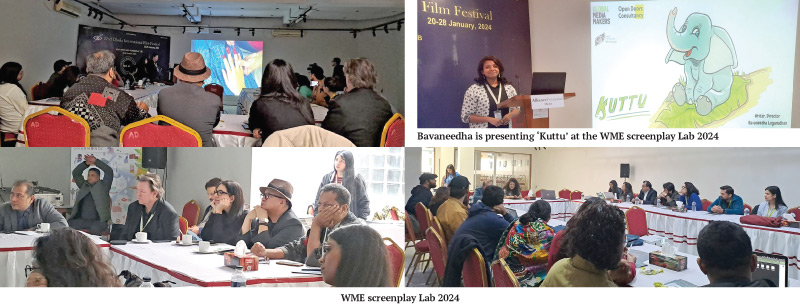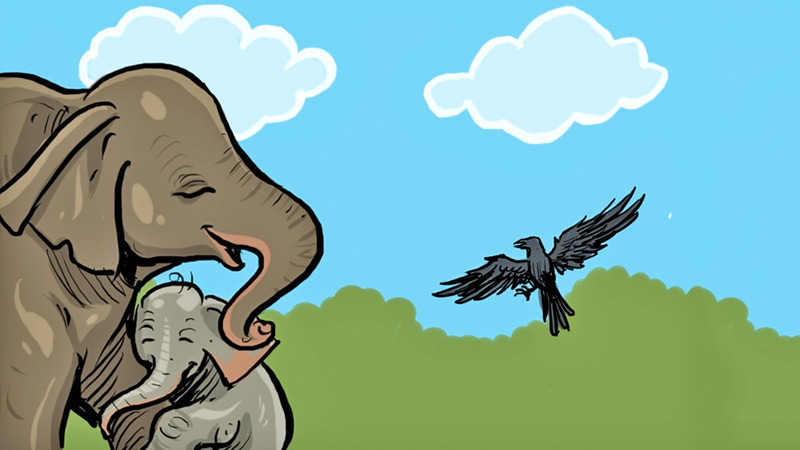The 22nd Dhaka International Film Festival just wrapped up, and Sri Lanka stole the spotlight with two big wins. Jagath Manuwarna snagged the Best Director award for his debut film “Whispering Mountains” in the Asian cinema category, while Bavaneedha Loganadhan nailed the third prize at the West Meets East Screenplay Lab.
The West Meets East Screenplay Lab, a brainchild introduced in 2022, aimed at bridging the gap between the Western film industry and Eastern filmmakers. Originally launched as a special section of the Dhaka International Film Festival, this initiative evolved into a platform where creativity knew no bounds. Continuously for the past three years scripts from Bangladesh, India, Nepal, Bhutan, Afghanistan, and Sri Lanka were meticulously shortlisted, showcasing the diverse narratives and untapped potential from the East.
For Sri Lanka, this win was a long time coming. In the inaugural WME screenplay lab in 2022, Sumudu Malalagama participated, and last year, Nipu Fernando and Bavaneedha both took part, though none of their projects secured a prize. Nevertheless, their participation influenced many Sri Lankan filmmakers to submit their projects this year, with seven projects submitted from Sri Lanka in this year’s WME screenplay lab, Bavaneedha’s project, “Kuttu,” was shortlisted and secured the third cash prize worth USD 2,000.
“Kuttu” is an animated fiction centred around a young elephant cub and her mother, inspired by Bavaneedha’s extensive research spanning several years on the human-elephant conflict.
Obsession in animation
Bavaneedha’s journey from a chaotic childhood marked by domestic violence, school bullying, and poverty to becoming a budding filmmaker is nothing short of inspiring. Cartoons served as her sanctuary, offering solace from the harsh realities she faced. Growing up, she grappled with understanding the complexities of human emotions, compounded by her own challenges with autism and dyslexia. For her, cartoons weren’t just entertainment; they were a window into understanding the world.
“Watching cartoons was my escape,” speaking to the Youth Observer Bavaneedha reflects. “It helped me grasp emotions and navigate through life’s ups and downs. I saw the world through the lens of animation, and it became an integral part of who I am.”
‘Kuttu’
Her passion project, “Kuttu,” has been a labour of love for four years. Immersed in the world of animation, Bavaneedha has meticulously researched every aspect of her craft. Despite the vast market for animation and the plethora of dedicated film festivals, she noticed a glaring gender disparity among filmmakers and producers in the field. Rather than being discouraged, Bavaneedha views this as an opportunity to make her mark. However, in Sri Lanka, opportunities to learn animation are scarce due to a lack of technological resources and the high cost associated with learning the medium. Despite these challenges, Bavaneedha’s interest in creating an animation about elephants persisted. It wasn’t until a shoot in Vavuniya that she encountered the reality of the human-elephant conflict firsthand, hearing numerous stories that fuelled her empathy for both parties involved.
Inspired by these stories, Bavaneedha delved into extensive research on the human-elephant conflict, drawing comparisons between Sri Lanka and Kerala elephants. She discovered that Sri Lankan elephants often face higher levels of stress, influenced by the treatment they receive. This research served as the foundation for her animation project, “Kuttu,” which gradually took shape over years of dedicated work.
“So, things got pretty interesting when I pitched “Kuttu” at the Film Independent Global Media Makers programme, all thanks to filmmaker Sanjeewa Pushpakumara for nominating me. I got some really helpful feedback from the program, and then there was the Locarno Consultancy, which was a game-changer. Money was tight, but I decided to dive into the project anyway, using funding from the British Council to kick things off with some comics before diving into animation,” she said.
Attending the Busan Film School program last year provided Bavaneedha further exposure with the opportunity to develop project proposals, including “Kuttu,” and network with animation artists from around the world. Building friendships within the animation community, particularly with her Indian friend Mahesh Ravan, enriched her understanding of the medium.
West Meets East Lab
Meanwhile, Bavaneedha’s participation in the West Meets East Screenplay Lab this January proved fruitful. Despite initial doubts, her project “Kuttu” was selected for the lab, where she received valuable mentorship and ultimately secured the third-place prize of USD 2,000.
“So, the WME Screenplay Lab put out the call for applications again for this year. I had my doubts about applying again since I’d already pitched one of my projects there last year. Anyway, I wanted to give ‘Kuttu’ a shot. Honestly, I didn’t have high hopes of being selected again. Well, luck was on my side because I got in again and also was able to win a prize too,” she added.
Artistic medium
“Kuttu” is an equally important project given Bavaneedha’s chosen artistic medium. Despite the success story of the record-breaking income of the home-grown animation ‘Gajaman’ by Chanaka Perera (Which is an exceptional case study.), animation is not a common artistic medium among Sri Lankan filmmakers due to various practical reasons. However, there is currently a huge demand for animation films worldwide, prompting many upcoming and renowned filmmakers to venture into this genre. The uniqueness of animation lies in its ability to convey a universal visual aesthetic understandable to any part of the world. This stands in contrast to live-action films, where visual aesthetics are often shaped by real socio-cultural surroundings that may not be universally understood. Although securing funds for an animation film in a country like Sri Lanka, where the medium is less common and exposure is limited, is quite challenging, Bavaneedha’s attempt to explore these emerging trends without stifling creativity in traditional filmmaking is thought-provoking.
Labs and opportunities
In this part of the world, financing or producing a film isn’t easy. However, there are various resources available, such as labs tailored for different stages of production and funding opportunities linked to film festivals and cultural institutes. Unfortunately, there’s a lack of necessary skills in this region, particularly in Sri Lanka, when it comes to applying for these funding opportunities and utilising labs effectively. Additionally, there’s a significant deficit in knowledge-sharing within this field and we often fail to engage with these platforms effectively. During my two-year observation of the WME screenplay lab, I found it to be an excellent platform in the region for emerging filmmakers. It offers valuable feedback, aids in project development, and, if fortunate, can even secure funding.
“Based on my limited experience pitching projects on global platforms, I’ve come to view these platforms more as avenues for rejection. However, understanding why a project is rejected can be a stepping stone to progress. In Sri Lanka, there’s a wealth of young talent producing interesting short films annually. Unfortunately, many of them struggle to find platforms to showcase their work or to determine which categories best suit their films, hindering their journey. It’s crucial for filmmakers to understand their own artistic identity rather than blindly following industry trends that may not align with their vision. Finding the right platform and funding source that match the film’s theme is essential. Regrettably, experienced individuals in the industry often fail to share knowledge or actively hinder others’ progress. As islanders, we tend to journey alone, but in filmmaking, teamwork is essential for success. We must view filmmaking as a competitive industry where collaboration is key to making our mark on the global stage. Increased participation in these platforms is essential for recognition. Therefore, thorough research and networking are indispensable.” Bavaneedha added.
 Speaking at the conclusion of the WME lab at Alliance Française in Dhaka, Yana Lekarska, a Jury member of WME lab, elucidated the rigorous selection process undertaken by the panel. Among hundreds of submissions, they faced the daunting task of shortlisting ten projects. “Judging the submitted scripts proved challenging,” Yana remarked, “as all participants presented remarkably strong projects.”
Speaking at the conclusion of the WME lab at Alliance Française in Dhaka, Yana Lekarska, a Jury member of WME lab, elucidated the rigorous selection process undertaken by the panel. Among hundreds of submissions, they faced the daunting task of shortlisting ten projects. “Judging the submitted scripts proved challenging,” Yana remarked, “as all participants presented remarkably strong projects.”
A Bulgarian screenwriter and director, Yana Lekarska boasts an MFA in Filmmaking from the prestigious South Korean university Chung-Ang. Her insights into Bavaneedha’s project underscored its exceptional qualities, not only in terms of storyline and character development but also for its potential to instigate positive change. “Bavaneedha’s dedication to this project is palpable,” Yana noted, expressing confidence in its future success. “With the feedback received during the lab from mentors, she will undoubtedly refine it into a film imbued with love and warmth, appealing not only to children but to audiences of all ages.”
Yana emphasised the transformative nature of the West Meets East screenplay lab, highlighting its role as a forum for international collaboration. “It offers an unparalleled opportunity,” she remarked, “to engage not only with colleagues and mentors from the region but also with individuals from diverse cultural backgrounds.” This diversity, she explained, is invaluable for ensuring clarity in storytelling, particularly concerning cultural nuances.
 Sadia Khalid Reeti, a film critic and screenwriter, serves as the co-convenor of the WME Screenplay Lab. Speaking exclusively to the Youth Observer at the lab’s final day, she disclosed that they received a total of 109 submissions, seeking projects from South Asia capable of elevating the region’s prestige. Factors such as project feasibility and the film team’s potential are also considered. While initial judgments are based on treatment, synopsis, and applicant profiles, final awards decisions rest solely with the jury board. Reeti expressed admiration for Bavaneedha’s project, citing her unwavering commitment to film production. “Bavaneedha’s animated feature, “Kuttu,” is poised to fill a void in South Asian cinema, addressing pertinent topics while contributing to the region’s animated film landscape,” Reeti stressed.She further expressed gratitude for the lab’s involvement in Bavaneedha’s journey.
Sadia Khalid Reeti, a film critic and screenwriter, serves as the co-convenor of the WME Screenplay Lab. Speaking exclusively to the Youth Observer at the lab’s final day, she disclosed that they received a total of 109 submissions, seeking projects from South Asia capable of elevating the region’s prestige. Factors such as project feasibility and the film team’s potential are also considered. While initial judgments are based on treatment, synopsis, and applicant profiles, final awards decisions rest solely with the jury board. Reeti expressed admiration for Bavaneedha’s project, citing her unwavering commitment to film production. “Bavaneedha’s animated feature, “Kuttu,” is poised to fill a void in South Asian cinema, addressing pertinent topics while contributing to the region’s animated film landscape,” Reeti stressed.She further expressed gratitude for the lab’s involvement in Bavaneedha’s journey.
Reflecting on the significance of participating in labs, Reeti emphasised the networking aspect over mentorship. Drawing from her own experiences in labs like Berlinale Talents and Locarno Open Doors, she underscored the value of forging connections with like-minded individuals. “These connections, formed during the lab, often evolve into invaluable collaborations or sources of support,” she said.
Reeti debunked the notion that labs provide comprehensive solutions to script problems, instead emphasising their success in fostering meaningful participant connections. “Over the past three years, the WME Lab has successfully facilitated such connections, enriching the experiences of its participants,” she said.







